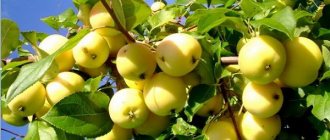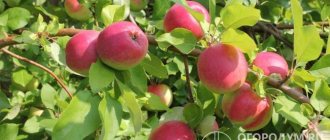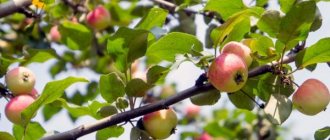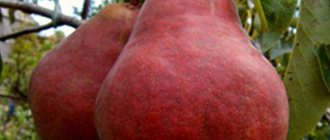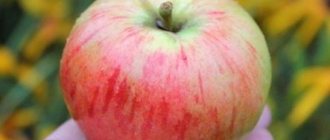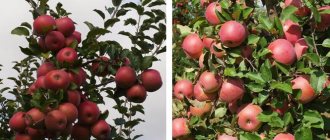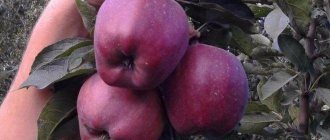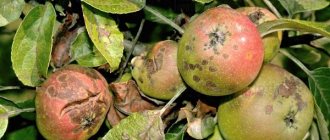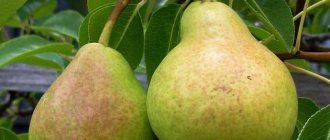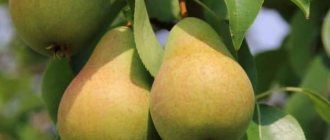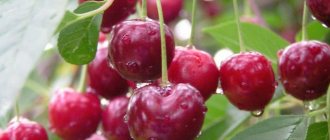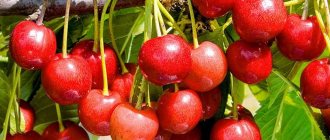The funny name of the Orlik apple tree is remembered well and for a long time. This is a very popular variety among gardeners .
Thanks to the active growth of the tree, tasty and healthy results - apples - are quickly obtained.
If the question arises, what kind of apple tree should you plant on your plot in order to eat fresh apples for a long time? Orlik may be the answer. If you follow the content recommendations, all your needs will be satisfied: without much work, there will be a lot of high-quality fruits.
Orlik apple trees are ideal for the central regions of Russia .
The taste and benefits of Orlik winter apples have long won the hearts of gardening enthusiasts and professionals.
Description
Back in 1959, at the fruit and berry station of the Oryol region, breeders took the Bessemyanka Michurinskaya variety and the Mekintosh (Makintosh) variety, crossed them and for the first time obtained a winter-ripening variety with a bright taste and aroma. The name “Orlik” was obtained from the territory where the apple tree with new varietal qualities was born.
Fruits of the Orlik variety:
Fruits of the Orlik variety.
For ten years, painstaking work has been carried out on three extremely important indicators :
- Frost resistance,
- High yield,
- Virus resistance.
Despite the stability inherent in the varietal characteristics, prevention of possible tree diseases is mandatory:
- Spraying in early spring with karbofos against green aphids and red mites;
- Before flowers appear on the tree, treatment with Bordeaux mixture against powdery mildew, fruit rot and scab;
- Whitewashing of trunks from pests in the bark, lichens and fungi to a height of up to 110 cm.
Attention! Apple trees of this variety can easily tolerate winters with frosts of 30 degrees, if the owner has taken preventive measures.
Protecting the apple tree from pests and diseases
Despite the good resistance of the variety to diseases and pests, trees should be regularly treated to prevent them in a timely manner.
Spraying with a 0.3% solution of karbofos will help against green aphids and red apple mites. It is carried out in early spring during bud break.
In the spring, before flowering, it is also necessary to treat the trees against scab, powdery mildew and fruit rot with a solution of one percent Bordeaux mixture. Spraying should begin with the soil near the trunk, gradually moving to the trunk and crown.
Whitewashing trunks is an effective preventive measure against pests living in cracks in the bark, as well as against lichens and fungi.
It is advisable to whitewash apple trees both in spring and autumn.
To prepare an effective mixture for whitewashing, you need to dilute 1–2 kg of clay, 1 kg of manure and 1 kg of slaked thick lime or chalk in 15 liters of water. After 3 days the mixture will be ready for use. The trunks should be whitewashed at a height of 1.5 m, deepening the whitewash to the underground part of the trunk by 5 cm, having previously dug the trunk to this depth, and after the procedure, bury it again. It is recommended to whitewash trees in early spring and late autumn.
additional characteristics
Height
The Orlik apple tree needs a small amount of space :
- The trees are medium-sized with smooth bark,
- They grow no more than 5 meters in height.
- Skeletal branches diverge horizontally from the trunk with their ends raised upward.
Crown width
The crown itself of an adult tree is spherical and relatively wide, up to 2 meters. The dark green leaf blades are round and large, the veins are clearly visible.
Winter hardiness
The apple orchard from Orliki is very resistant to severe frosts - this is one of the distinctive advantages of the variety.
However, it is better to mulch the soil with humus around the trunk and wrap it with nylon or burlap to protect against spring sunburn and rodents.
Pollinator varieties
The Orlik apple tree variety needs special pollination , since it is not a self-pollinating variety.
The following varieties of apple trees are well suited for cross-pollination :
- Bogatyr,
- Renet,
- Northern signal,
- Moscow winter,
- Chernenko.
In order not to purchase them specifically and to avoid additional costs, you can ask your neighbors what varieties of apple trees they grow.
Self-fertility
Orlik is a self-fertile variety and does not depend on weather conditions. The level of fruiting in Orlik is high.
A fifteen-year-old tree can produce a harvest of 100 kg per season. Maximum yields are recorded at 120 kg per tree. One apple can weigh from 110 to 200 grams.
Tasting assessment
4.1 points out of 5. Tasters note a unique sweet harmonious taste with a slight sourness of soft creamy pulp. Each fruit contains more than 150 mg of microelements and a whole vitamin complex, as well as sugars and pectins.
Important! Orlik apples are recommended for consumption for dietary purposes and for metabolic disorders in the body. They are included in the diet for the prevention of atherosclerosis and after heart attacks.
Apples on the branches.
Flaws
The only two inconveniences in the care and maintenance of this variety:
- If you miss the moment of fruit ripening , the apples will partially fall to the ground; they must be collected so as not to cause rot under the tree;
- The presence of unregulated dormant periods without fruiting.
Advantages and disadvantages
Like all varieties of apple trees, Orlik has its positive aspects, which is why it is loved and often planted. But some disadvantages can be noted, which gardeners also point out.
Advantages
It’s worth saying right away that most reviews about this variety are positive. The advantages include:
- Precocity. Apples ripen in a fairly short time for their varietal range;
- Frost resistance. This is not unimportant for any cultures in our country;
- High yields. They are usually quite stable. At the same time, many people like the tendency for yield to increase as the tree ages;
- Excellent taste and aroma. Indeed, the fruits are very juicy, they are well suited for fresh consumption and making juices. And the aroma of apples is especially bright and intense.
- Transportability. If properly preserved, the fruits can last for a very long time. In addition, they are easy to transport, since they do not deteriorate at the slightest damage;
- Compactness. Due to the fact that the trees grow small, the variety is very easy to grow in gardens. Without taking up too much space, it produces a good harvest.
- Undemanding neighborhood. Orlik apple trees are not whimsical in this matter. They can grow next to other crops absolutely calmly, without losing their qualities.
- Sustainability. This refers to the resistance of trees to both pests and diseases.
- Easy to care for. It is also of great importance. If the plant does not require much attention and effort, but produces a lot of fruit, then the variety can be considered very good.
Flaws
Among the few disadvantages of the variety are the following:
- There are cases when fruits begin to fall off ahead of time, just starting to ripen;
- The variety does not bear fruit regularly, which does not suit many gardeners;
- Small fruits. Orlik apples are really small;
- Self-sterility:
Sources used:
- https://diz-cafe.com/sad-ogorod/sort-yabloni-orlik-foto-i-opisanie-sorta.html
- https://dachamechty.ru/yablonya/orlik.html
- https://sadsezon.com/sad/plodovie/yabloni/sorta/o/orlik.html
- https://dacha.help/frukty-i-yagody/yabloni-orlik-sort
- https://qlumba.com/sad/frukty/2279-yablonya-orlik
- https://maja-dacha.ru/yablonya-orlik-idealnyiy-sort-dlya-vyirashhivaniya/
- https://1001sort.ru/yablonya-orlik.html
Reviews from gardeners
Denis : “We have a young family; five years ago we started developing a small summer cottage in the Leningrad region. There was no experience. We looked for information about the variety: description, photos, reviews, planting and how it is done. Three Orlik apple trees were planted along a 10-meter fence. In the second year after planting, the apple trees produced flowers and several fruits.
Every spring they look like ornamental trees with red and then pink flowers. The neighbors are surprised. The trees grew quickly and take up little space. There are enough apples until spring, we eat them fresh. We know that it can be used in compote or jam, but it is better to give fresh fruit to children, especially in winter when there is a lack of vitamins.
We love our orliks and recommend them to everyone not only for their delicious fruits, but also for their easy care.”
Mikhail : “Orlik is a variety of apple trees that only have advantages if you know what needs to be done and when. The trees are not tall, it is convenient to pick apples from the branches without any ladders or stepladders. We have two apple trees, we bought them after looking at the photo and description of the variety. Until March, just get some apples, delicious things. Our neighbors Renet helps our Orliks to pollinate. Since August we’ve been eating apples straight from the branch, delicious, delicious.”
Marina : “I read about Orlik’s shortcomings when I studied the description and photo, but I didn’t find it in real life. The variety does not require any special trouble. The area near Pskov is bright, with a slight slope. Three apple trees have been planted; they are already more than 10 years old. Between them there are beds with vegetables, there is enough light for everything to ripen: cabbage, carrots, and apples.
We collect 50 kg of apples from each tree in September . We carefully place red apples in wicker baskets; they are stored perfectly. Last winter we experienced three days of 40-degree frosts. The plum tree froze, but the Orlik apple trees survived.”
Orlik apple tree.
Apple tree variety Sinap Orlovsky: description and pollinators
Lazy tomato: characteristics and description of the variety, reviews, photos, advantages, application
The Sinap Orlovsky apple tree is a late-winter variety. This fruit crop was bred in 1955 by a group of Russian breeders, headed by Evgeniy Nikolaevich Sedov. Scientific work on the development of a new fruit crop took place on the basis of the All-Russian Research Institute of Horticulture named after. I. V. Michurina.
The varieties Sinap northern and Pamyat Michurina took part in the breeding experiment. Today, the Sinap Orlovsky variety is cultivated in many regions of Russia, Ukraine and Belarus.
According to the description, this fruit crop is zoned for cultivation in horticultural farms of the Central, Central Black Earth, Northwestern and Middle Volga regions of the Russian Federation.
Tree
Sinap orlovskiy is a vigorous fruit crop. The height of an adult tree depends on the growing conditions and can range from 3 to 5 m. The crown is spreading, round or pyramidal in shape, but not dense.
Thick skeletal branches are located sparsely and perpendicular to the trunk, which facilitates further care and harvesting. The shoots are of medium thickness and drooping.
The leaves are wide at the base. The edges of the pointed leaf blade are turned upward. Depending on the amount of sunlight, the leaves come in different colors - from grassy to dark green.
Fruit
The Sinap Orlovsky apple variety has a round-conical or oblong shape, with the top slightly flattened. The average fruit weight is 150 g.
The skin is dense, smooth, covered with a glossy coating. At the time of technical maturity, the peel has a yellow-green tint; after a few weeks of storage, the apple becomes yellow-golden. The side facing the sun is covered with a blurry red blush.
The pulp is juicy, loose structure, pale green in color. The taste of Sinap Orlovsky apples is sweet, with a hint of honey. The fruits of this fruit crop can be eaten fresh or used as raw materials for the production of apple marshmallows, jam, preserves, fruit drinks and juice.
Advantages and disadvantages
According to reviews from experienced gardeners, the Sinap Orlovsky apple tree variety has many positive qualities:
- consistently high yields - 130–200 kg of apples per mature tree;
- early fruiting - the first harvest is harvested in the 4th year of planting the seedling in a permanent place of growth;
- excellent winter hardiness, suitable for growing in the northern regions of Russia;
- long shelf life and good transportability;
- excellent taste and commercial properties of the fruit.
The disadvantages of the Sinap Orlovsky variety include:
- the Sinap Orlovsky apple tree, characterized by its large dimensions, requires a large planting area;
- weak resistance to scab and pathogens of other fungal diseases;
- high sensitivity to lack of calcium in the soil;
- self-sterility.
Variety varieties
Thanks to the efforts of domestic breeders, several subspecies of the Sinap Orlovsky apple tree variety were bred:
- On a dwarf rootstock. The height of an adult tree does not exceed 2.5–3 m, while the root system reaches only 1.5–2 m in depth. An apple tree grown on a dwarf rootstock is suitable for cultivation in a garden plot with close groundwater.
- On a semi-dwarf rootstock. The apple tree begins to bear fruit 4–5 years after the seedling is planted. The maximum root depth is 2.5 m, and the tree height is 4.5 m.
- On a vigorous rootstock. This variety of apple tree, Sinap Orlovsky variety, begins to bear fruit late, reaches a height of 5–6 m, but is able to feed on moisture from deep sources.
- On clonal rootstock. This is a tall fruit tree with a wide spreading crown. The tree is resistant to attacks by harmful insects and pathogens of viral and fungal infections. An apple tree on a clonal rootstock is one of the most undemanding fruit crops to care for. As for the disadvantages, it is worth noting the late fruiting of this fruit crop. The first harvest is harvested only in the 10th year of the fruit tree’s life.
Features of agricultural technology
The Sinap Orlovsky apple tree variety is self-sterile. In order for the plant to bear fruit, pollinating trees need to be planted nearby.
Like all fruit trees, the Sinap Orlovsky apple tree loves the sun and soil rich in nutrients.
When choosing a place to plant a seedling, it is recommended to avoid wetlands and high groundwater levels.
Landing
Deadlines
Seedlings are placed in prepared soil in September-October .
Peculiarities
When choosing a place for apple tree plantings, pay attention to the fact that the site is not low-lying, away from water bodies, and that groundwater is no closer than two meters from the roots of the tree.
Important! Overmoistening of the root system leads to rotting of the fruit in the future.
In small areas, the Orliks will fit well and compactly at a distance of two meters from each other.
Ideal soil mixture composition:
- A little clay
- Sand,
- Peat,
- Humus and compost.
When planting a seedling in a hole, the root collar should be 7 cm above ground level. The root system is well straightened and covered with nutritious soil. Compact tightly and pour at least 5 buckets under the seedling - the next mandatory steps when planting an apple tree.
Care
To ensure that the tree grows evenly, pegs are installed on both sides and the seedling is tied to them. In a couple of years, the structure can be dismantled.
Pruning and crown formation
Spring sanitary cleaning of the crown is required for all trees ; Orlik apple trees are no exception.
All dry branches affected by diseases or pests are removed. Thinning the crown increases the yield of the apple tree.
It should be remembered that there is also a limitation in this matter: the maximum volume for cutting branches is no more than a quarter of their total number.
Top dressing
In the first year there will be enough food.
Starting from the second year , in the spring, apple trees of the Orlik variety are fertilized with urea and ammonium nitrate, wood ash is scattered around the trunk, lightly digging up the soil.
In the fall, mature trees are given liquid fertilizer from mullein with the addition of superphosphates and ammonium nitrate, poured in a bucket under the trunk.
Features of ripening and fruiting
Beginning of fruiting
After planting the apple trees, only 4 years and you can reap an excellent harvest. Experienced gardeners claim that 45 kg ripens on a tree at the age of 5-7 years.
Peculiarity! It is better to remove 80% of the flowers from the apple tree in the first year in order to increase the rate of establishment of the young tree.
Bloom
Orlik apple trees bloom in spring and early summer. Fragrant large flowers bloom first red, then delicate pink.
Apple tree blossom.
Ripening time
The fruits are harvested along with those varieties that ripen in the fall, usually in mid-September.
Fallen apples will not last long; it is better to put them into processing.
Place apples with stems in 2-3 layers in wooden boxes carefully, without damaging the skin. Sometimes they are sprinkled with clean sawdust.
Then they are placed in a cellar, refrigerator or attic, at a temperature no higher than 5 degrees .
Appearance of fruits
The fruits are slightly cone-shaped in shape and medium in size.
Ripe apples are yellow with pink spots on the sides. Under the thick skin with a waxy coating, the flesh is juicy and dense. The wax coating protects the fruit from harmful bacteria and fungi.
Shelf life
In excellent presentation, apples lie in baskets and boxes in a thin layer at low temperatures until March.
Features of growing the variety in the regions
Since the end of the last century, apple trees of the Orlik variety have become a fixture in garden farms and private garden plots in the Central Region, Central Black Earth and North-Western regions.
The compact size of the tree and high yield have gained great popularity.
Orlik is successfully grown in the Moscow region, in the middle zone and in the Urals.
Siberia is less suitable for growing this variety of apple trees, since very low winter temperatures can be maintained for a long period, which will negatively affect the development of the tree and its fruiting, even if all preventive measures are taken.
Origin and zoning
Domestic, proven variety. It was bred back in 1958 on the basis of the All-Russian Research Institute for Breeding Fruit Crops by famous specialists E. N. Sedov and T. A. Trofimova by hybrid crossing of popular varieties of the crop: “Mekintosh” and “Bessemyanka Michurinskaya”.
In the photo are the parent forms: “Mekintosh” (left) and “Semyanka Michurinskaya” (right)
In 1970, the seedlings identified as the elite were submitted for state testing, and 16 years later the variety was officially included in the State Register of Breeding Achievements of the Russian Federation and patented in 1998.
Due to its average winter hardiness, “Orlik” is zoned and recommended for industrial and amateur gardening in the North-Western, Central and Central Black Earth regions of our country. Thanks to a number of advantages and high ecological adaptability, this variety of apple tree is successfully grown in Ukraine, Belarus and other neighboring countries.
